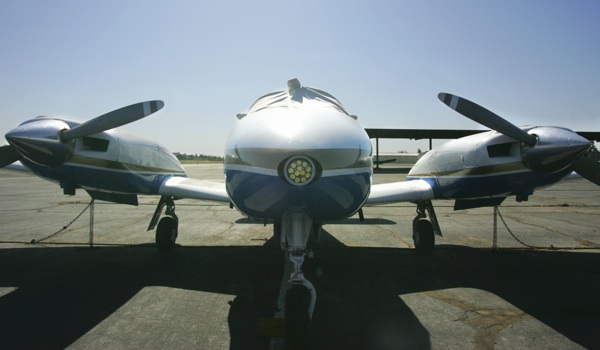In the state of California, UC Davis is the only university with an on-campus airport. From business and recreational travel to flight training and atmospheric studies, the University Airport serves the Davis community in a variety of ways.
“Aviation is starting to be taken for granted. At some point there was a knowledge and understanding of how crucial aviation is for a local economy,” said Jonathan Bar-or, chief pilot and chief executive officer of Cal Aggie Flying Farmers (CAFF). “[The airport] is probably the coolest hidden gem at this university or in the city of Davis. Not just the fact that we have an airport, but the fact that we have an airport with the highest caliber training facility on its file.”
In order to show off the airport facilities to the campus community, both the Friends of the University Airport and UC Davis Transportation and Parking Services will be hosting the 11th annual University Airport Open House on Saturday, Oct. 19 from 10 a.m. to 2 p.m.
“It’s more for the education of what we do,” said Bill Hartman, a representative of The Friends of the University Airport. “To let the people in town and the new students know what aviation is about.”
From standard aircrafts to antique automobiles, many attractions will be on display for visitors. Professional pilots and former National Aeronauttics and Space Administration (NASA) employees will also be attending to explain the academic aspects of the event.
“[The hangars] will be open and full of [UC Davis] students. We will have at least two different flight simulators, so you can sit down, fly on a computer and feel like you’re flying an airplane,” said mechanical and aerospace engineering professor and former NASA astronaut Stephen Robinson. “If anyone has even the slightest curiosity about flying, about aerospace engineering, or about what’s out there on the other side of the 113, come on out.”
Since his return to UC Davis last year, Robinson has made many efforts to involve students with the airport’s academic value.
“My role is to connect the university’s primary mission, education, with the airport and aerospace engineering,” Robinson said. “We are interested in making airplanes safe, in demonstrating the principles of aerospace engineering in real life.”
Students, specifically in the aerospace engineering department, work voluntarily every quarter with different airport facilities, such as the hangars and wind tunnel.
“Right from the beginning, my intent was to take advantage of the very unique opportunity that the airport offers students here at UC Davis,” Robinson said. “It affords us a very unique combination of educational opportunities between the various departments here and the facility so that students can get hands on physical exposure to aerospace.”
The airport facility has come a long way since its original start. In 1947, engineer Harold Hopkins bought the land with the idea of creating an airport to fly fruits and vegetables across the country, considering Davis as the breadbasket of the nation.
The University Airport land was bought by the University of California Board of Regents in the early 1950s and has been run that way ever since, now serving hundreds of people daily.
“The whole role of aviation in the United States is for transportation and research, and we need to support that,” Hartman said. “The bigger airports are impacted with airline traffic. So, you need the smaller airports like this to support the smaller airplanes.”
Although the University Airport does not operate through commercial airlines, over 50 planes take off from the airport’s runway every day. UC Davis professors, visitors and veterinary hospital animals constitute only a few types of typical flight passengers.
“There are some major Silicon Valley employees that commute [by plane] from Davis to the Bay Area every day,” Bar-or said. “Airports like this are the tie from these communities to technological powerhouses. Without the airport, we would lose a lot of community members.”
Many of the flights described are administered by one of the 400 members of the non-profit CAFF. Although the University manages the airport in terms of buying fuel and maintaining the grounds, CAFF handles 80-90 percent of the facility’s daily functions.
Since 1947, the on-campus Davis flying club has offered flying lessons and aircraft rentals to students, university associates and the general public from the University Airport itself. With seven full-time flight instructors, affordable pricing and one-on-one classes, flying is a universal activity, according to Bar-or.
“Anyone can come learn to fly and see the University from the air,” Bar-or said. “It’s amazing what you learn by doing something as hands on and out of the box as learning how to fly.”
After a pre-briefing in one of the flight instructor rooms on site, flight school students begin their lessons off the ground. With dual control airplanes, students learn techniques and strategies in the air without the expected pressure of being inflight.
Students in the flying program also receive ground instruction regarding topics necessary for flight, such as weather phenomenon. After accumulating an average of 60 to 70 hours in the air, pilots-in-training take both oral and flight exams with the Federal Aviation Administration at the University Airport.
More information regarding flight lessons and other airport services will be available at the Open House. In addition, the CAFF will have a drawing for a free introductory flying lesson.
“Students have limited time, but they don’t have limited energy. They have unlimited energy, unlimited creativity and an unlimited thirst to learn,” Robinson said. “All the university facilities are our facilities. It’s your airport, you should come see it.”
RITIKA IYER can be reached at features@theaggie.org.





[…] The Aggie […]